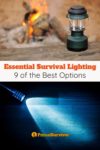Survival lighting is an often overlooked yet vitally important consideration for preppers.
Several options are available; some are better for specific situations or tasks than others. For example, you wouldn’t want to use a flame-based light if there was a suspected gas leak.
This article will cover:
- The different types of survival lighting
- Which survival lighting is best
- The supplies you need to stay illuminated in an emergency
Types of Survival Lighting
1. Flashlight

Best For: Task lighting
Flashlights range from the cheap ones you can find at the Dollar Store to more advanced survival flashlights.
They have a one-directional beam, so they are unsuitable for illuminating entire rooms. You also have to hold them in your hands, so they aren’t good for any situation where you’d need both hands (like hiking in the dark on rough terrain, boarding up a window, or repairing equipment).
Thus, flashlights aren’t great for survival situations – especially compared to headlamps. But flashlights do have the benefit of being cheap. High-lumen flashlights are also helpful when you need bright task lighting and have someone who can hold the flashlight.
See:
2. EDC Flashlights
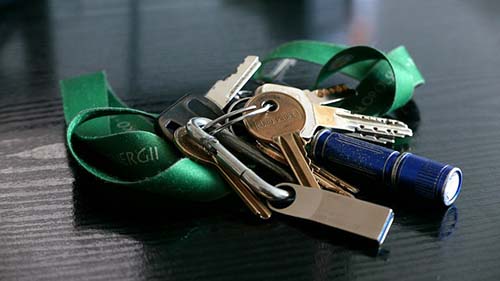
Best For: Everyday carry
An Everday Carry (EDC) flashlight is compact and lightweight compared to regular flashlights. This makes it practical to carry on your keychain or in your purse. It’s one of the essential survival items to always have with you.
3. Headlamp
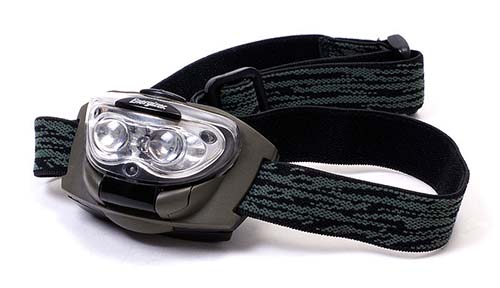
Best For: Task lighting, bugging out
Compared to flashlights, headlamps have the advantage of being hands-free. This makes them much more suitable for task lighting, such as if you need to go into the basement to shut off the power main, carry equipment in the dark, or need to go to the bathroom at night.
Headlamps are also best for bugging out because you can wear them hands-free while hiking on rugged terrain.
The only downside of headlamps as your survival lighting is that the good ones tend to be pricey. Cheap headlamps blow through batteries quickly, are bulky to wear, and aren’t as reliable.
4. Electric Lantern
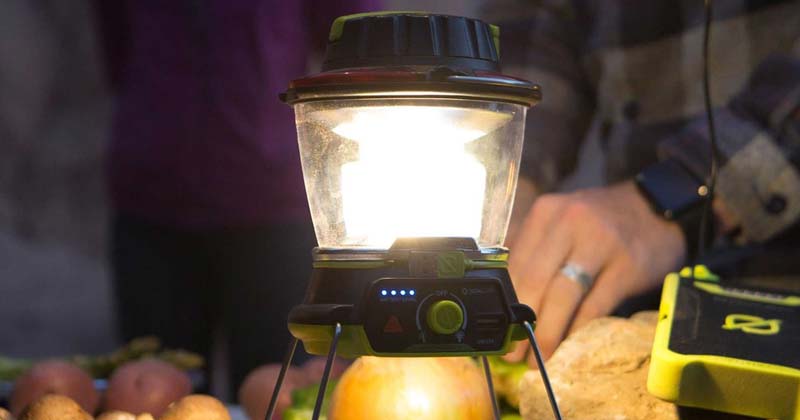
Best For: Lighting an entire room or space
Lanterns usually provide 360 degrees of ambient lighting, so they are the best option for lighting up an entire room. There are a lot of great electric lanterns to choose from.
When choosing a survival lantern, the main thing to look at is the power source, such as whether they use batteries or be recharged with a USB, hand-crank, or a built-in solar panel.
*Note that lanterns are generally meant to be portable while lamps are stationary. However, the terms lantern and lamp are often used interchangeably.
See our picks for emergency lanterns.
5. Fuel-Based Lamps

Best For: Long-term power outages, EMP
Lamps are one of the oldest types of survival lighting. People used simple vegetable oil lamps thousands of years ago to light their homes. Later, people began using kerosene lamps, but it’s fallen out of favor because kerosene burns dirty.
More modern lamps use propane gas or candles.
The benefits of using lamps as your survival lighting are that they are cheap, easy to make yourself, and don’t require any electric components (so they would be fine for EMP preparedness).
However, there’s always a risk of fire with flame-based lighting. They are NOT recommended for earthquake preparedness, use during hurricanes or other situations where gas main leaks are likely, or they could be knocked over.
6. Candles

Best For: Long-term power outages, EMP
Candles are one of the simplest and cheapest survival lights you can get. They have the advantage of being reusable: save the wax, melt it, and make candles out of it with a new wick. Because there are no electrical components, candles are suitable for EMP preparedness.
But there are many downsides to candles as survival lighting. Aside from the obvious fire risks, candles don’t provide much light, and you can’t adjust the brightness. This makes them unsuitable for task lighting and things like bugging out.
I’d only recommend them for long-term power outages where recharging batteries might not be possible.
Read:
7. Solar Garden Lights
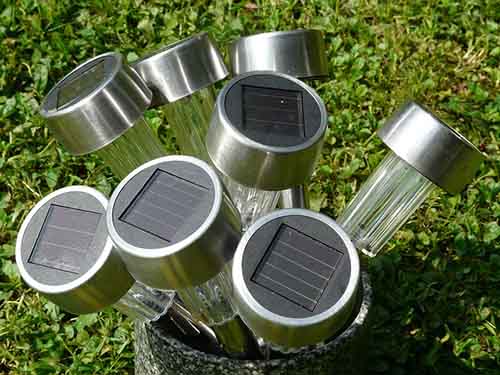
Best For: Nightlight
These types of solar lights have built-in batteries which are directly connected to a solar panel. They are designed for outdoor use and can only be charged by solar panels, not batteries, USB, etc. (which makes them different from solar-powered flashlights or lanterns).
Most solar garden lights aren’t very bright (some only produce 5 lumens or less!). However, they have the benefit of being very cheap. They are great to keep in bathrooms, hallways, or children’s rooms as a nightlight during power outages. There are also more powerful solar outdoor lights, but these tend to be pricier.
8. Glow Sticks & Chemical Lights
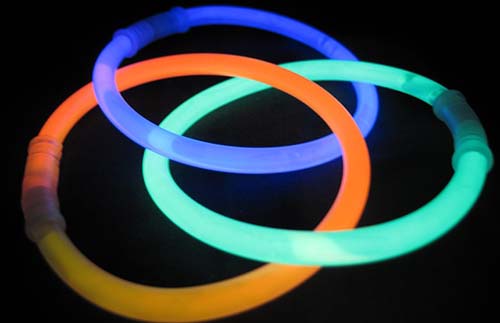
Best For: Children
Glow sticks usually only provide a few lumens of lighting, which isn’t enough to light up a space or provide task lighting. However, they are great for children during power outages. You can have your kids wear glow sticks so you can easily find them. Kids also like glow sticks, so it is good for their morale – especially if they are afraid of the dark.
9. Torches

Best For: SHTF lighting
If you have nothing else, torches are an option in a pinch. You can make a torch out of many things. One cool primitive method is to use your survival knife to cut several deep notches into the end of a long branch. You then put some wet clay or moss into the notched area, followed by pine pitch. The pine pitch burns for a very long time and withstands wind well.
Read: How to Make Pine Pitch from Sap
Which Survival Lighting Is Best?
Overall, headlamps and electric lanterns are the safest and most useful types of survival lighting. However, these will eventually run out of batteries or need to be recharged, so you’ll want a backup option for long-term preparedness.
Ideally, you would get several types of survival lights to ensure all of your needs are covered. Here’s what I recommend.
- Hunkering Down: Headlamp, electric lantern, solar garden lights, candles, and candle lamp
- Bugging Out: Headlamp and glow sticks for kids
- Car: High-lumen flashlight and/or headlamp
- EDC: Small tactical flashlight
And here are some recommended products to consider:
Other Survival Lighting Essentials
In addition to lights, you’ll need some other gear to stay illuminated through emergencies. Make sure you also have:
Lighters
You’ll need these to light candles, fuel-based lanterns, or torches.
Read:
Spare Batteries
Generally, you should have 10 spare batteries for each survival item that uses them. Some batteries are much better than others, so you might only need 5 per light if you’ve got good batteries. Also, remember that batteries can drain when not used, especially if not stored properly.
Read:
Way to Recharge Batteries and Lights
In case of a long-term power outage, you’ll want to be able to recharge batteries.
Read:
